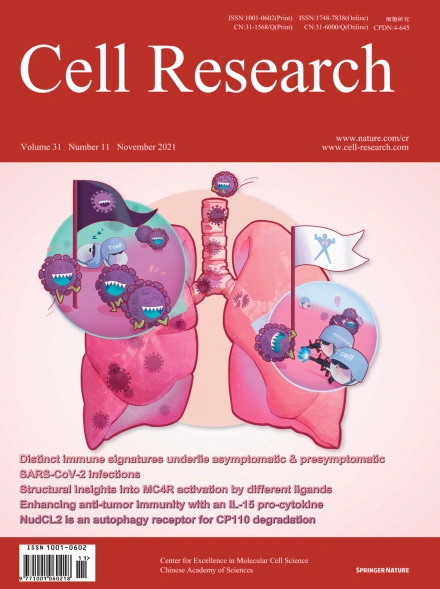Volume 31 Issue 11, November 2021: 1163-1175
ORIGINAL ARTICLES
Structural insights into ligand recognition and activation of the melanocortin-4 receptor
Huibing Zhang1,2,3,4,† , Li-Nan Chen1,2,3,4,† , Dehua Yang5,6,7,† , Chunyou Mao1,2,3,4 , Qingya Shen1,2,3,4 , Wenbo Feng8 , Dan-Dan Shen1,2,3,4 , Antao Dai5,6 , Shanshan Xie9 , Yan Zhou5,6 , Jiao Qin1,2,3,4 , Jin-Peng Sun10,11 , Daniel H. Scharf12 , Tingjun Hou13 , Tianhua Zhou9 , Ming-Wei Wang5,6,7,8,14,15,* , Yan Zhang1,2,3,4,*
1Department of Biophysics and Department of Pathology of Sir Run Run Shaw Hospital, Zhejiang University School of Medicine, Hangzhou, Zhejiang, China
2Liangzhu Laboratory, Zhejiang University Medical Center, Hangzhou, Zhejiang, China
3MOE Frontier Science Center for Brain Research and Brain-Machine Integration, Zhejiang University School of Medicine, Hangzhou, Zhejiang, China
4Key Laboratory of Immunity and Inflammatory Diseases of Zhejiang Province, Hangzhou, Zhejiang, China
5The CAS Key Laboratory of Receptor Research, Shanghai Institute of Materia Medica, Chinese Academy of Sciences, Shanghai, China
6The National Center for Drug Screening, Shanghai Institute of Materia Medica, Chinese Academy of Sciences, Shanghai, China
7University of Chinese Academy of Sciences, Beijing, China
8School of Pharmacy, Fudan University, Shanghai, China
9Department of Cell Biology and Cancer Institute of the Second Affiliated Hospital, Zhejiang University School of Medicine, Hangzhou, China; Institute of Gastroenterology, Zhejiang University, Hangzhou, China; Collaborative Innovation Center for Diagnosis and Treatment of Infectious Diseases, Hangzhou, Zhejiang, China; Department of Molecular Genetics, University of Toronto, Toronto, Ontario, Canada
10Department of Physiology and Pathophysiology, School of Basic Medical Sciences, Peking University; Key Laboratory of Molecular Cardiovascular Science, Ministry of Education, Beijing, China
11Key Laboratory Experimental Teratology of the Ministry of Education, Department of Biochemistry and Molecular Biology, School of Basic Medical Sciences, Cheeloo College of Medicine, Shandong University, Jinan, Shandong, China
12Department of Microbiology and The Children’s Hospital, Zhejiang University School of Medicine, Hangzhou, Zhejiang, China
13Innovation Institute for Artificial Intelligence in Medicine of Zhejiang University, College of Pharmaceutical Sciences, Zhejiang University, Hangzhou, Zhejiang, China
14School of Life Science and Technology, ShanghaiTech University, Shanghai, China
15Department of Pharmacology, Fudan University, Shanghai, China
†These authors contributed equally: Huibing Zhang, Li-Nan Chen, Dehua Yang
Correspondence: Ming-Wei Wang(mwwang@simm.ac.cn)Yan Zhang(zhang_yan@zju.edu.cn)
Melanocortin-4 receptor (MC4R) plays a central role in the regulation of energy homeostasis. Its high sequence similarity to other MC receptor family members, low agonist selectivity and the lack of structural information concerning MC4R-specific activation have hampered the development of MC4R-seletive therapeutics to treat obesity. Here, we report four high-resolution structures of full-length MC4R in complex with the heterotrimeric Gs protein stimulated by the endogenous peptide ligand α-MSH, FDA-approved drugs afamelanotide (Scenesse™) and bremelanotide (Vyleesi™), and a selective small-molecule ligand THIQ, respectively. Together with pharmacological studies, our results reveal the conserved binding mode of peptidic agonists, the distinctive molecular details of small-molecule agonist recognition underlying receptor subtype selectivity, and a distinct activation mechanism for MC4R, thereby offering new insights into G protein coupling. Our work may facilitate the discovery of selective therapeutic agents targeting MC4R.
https://doi.org/10.1038/s41422-021-00552-3
FULL TEXT | PDF
Browse 974


